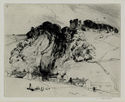
19th, 20th & 21st Century Fine Prints
707-546-7352 · fax 707-546-7924 · web: www.annexgalleries.com · email: artannex@aol.com
Frank Short Biography
Frank Short
British
1857–1945
Biography
Sir Francis (Frank) Job Short was born on June 19, 1857 and grew up in the village of Wollaston, Worcestershire, adjoining Stourbridge in the Midlands of England. He studied and became a civil engineer. He was engaged on various works in the Midlands until 1881, when he moved to London as the assistant to Baldwin Latham assisting with the Parliamentary Inquiry into the pollution of the Thames River. He began studying art at both the Kensington and Westminster Schools of Art.His became an engraver of both original and illustrative engraver. He was a student of the works of JMW Turner and his etchings and mezzotints from Turner's Liber Studorium (1885 seq.) are examples of his painstaking devotion and skill. These works were among his earliest successes, combining sympathetic study of the originals with a full knowledge of the resources of engraving and unwearied patience. Short received praise, constant advice and encouragement from Ruskin and the co-operation of students of Turner. After completing the series from the existing plates of Turner's "Liber" Short turned to the subjects which Turner and his assistants had left incomplete. Several fine plates resulted from this study, bearing the simple lettering "F. Short, Sculp., after J. M. W. Turner, R.A.," which told little of the work expended on their production, even before the copper was touched.
As head of the Engraving School at the Royal College of Art, South Kensington, Short had great influence on younger engravers of the time. He was elected to the Royal Society of Painter-Etchers and Engravers in 1885, and took a prominent part in conducting its affairs. In 1910 he succeeded Sir Francis Seymour Haden as president, serving as such until 1939.
Short received, amongst other distinctions, the gold medal for engraving at the Paris International Exhibition, 1889, and another gold medal (Rappel) 1900. In 1906 Short was elected an Associate of the Royal Academy, when membership as Associate Engraver was revived and in 1911 he was elected a full Royal Acadamician (R.A.), and also received a knighthood. Frank Short and Whistler became friends around 1885 and, according to Robert Getscher in his book 'The Stamp of Whistler': "Whistler was attracted by Short's skill and often visited him in the nineties to ask for help with technical matters, such as the formulas for etching baths. He proofed some of his last plates in Short's studio."
In 1888 Short published an etching 'how-to' manual for etchers titled "On the Making of Etchings" which became a bible for many etchers of the time. The Etched and Engraved Work of Frank Short, by Edward F Strange (1908), describes 285 plates by the artist.
Sir Frank Short died in Ditchling, East Sussex, England on April 22, 1945.



